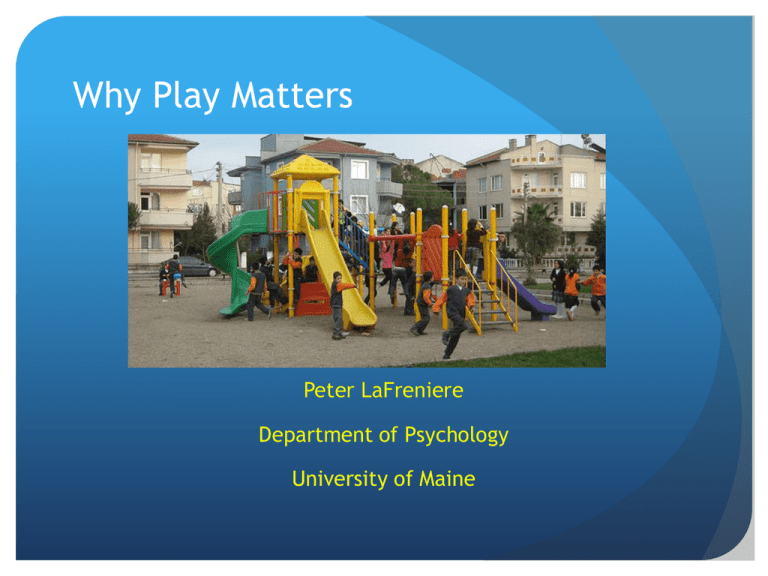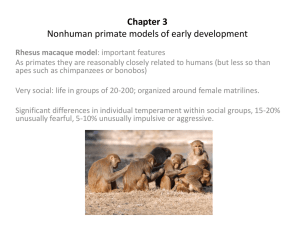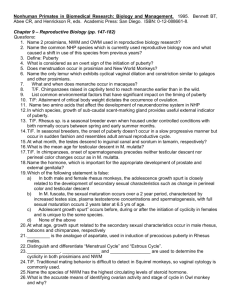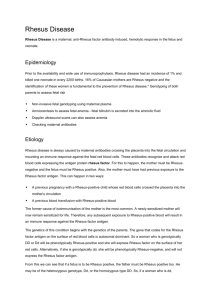
Why Play Matters
Peter LaFreniere
Department of Psychology
University of Maine
Snap the Whip - 1872
The Old Stagecoach -1871
These 19th century works by Winslow Homer and
Eastman Johnson reveal key features of play
Absence of adult structure and supervision
Physical exercise & absence of obesity
Creativity and imagination
Contact with the natural world
Influence of culture
Gender segregation & behavioral compatibility
Mixed-age play
And last but not least:
The children appear to be having fun!
Golden age of unstructured play
Unstructured play refers to play that is structured by
children themselves, rather than by adults.
During the first half of the 20th century children were
relatively freed from long hours of labor, by child labor
laws.
There was a positive attitude toward children’s free
play and the development of parks and other play
spaces to promote it.
Decline of Free Play
Over the past half-century, in the US and other
developed nations, opportunities to play outdoors with
other children have been continually declining.
This decline in play, over the past five to six decades, is
becoming disquieting to developmental psychologists.
The greatest decline has been in children’s outdoor
play.
Anyone more than a few decades old has seen this
change in his or her lifetime.
In the 1950s and ‘60s, and to a lesser degree in the ‘70s
and ‘80s, it was possible to walk through almost any
North American neighborhood, after school, on
weekends, or any time in the summer, and see children
playing outdoors.
Today, in many neighborhoods, it is hard to find groups
of children outdoors at all, and if you do find them they
are likely to be wearing uniforms and following the
directions of coaches while their parents dutifully watch
and cheer.
These changes have been well documented by historians
of play.
Precisely how fast and exactly how much children’s free
play has declined over the last half century is difficult
to quantify, though all historians of play suggest that it
has been continuous and great.
The most objective attempt at such quantification was
by sociologists at the University of Michigan, who made
assessments of how children spent their time in 1981
and again in 1997.
In both years, they asked a large, representative sample
of parents in the United States to keep diary records of
their children’s activities on days chosen at random by
the researchers.
They found that children not only played less in 1997
than in 1981, but apparently had less free time for all
self-chosen activities in 1997 than in 1981.
From 1981 to 1997
For 6- to 8-year-olds:
25% decrease in time spent playing
55% decrease in conversing with others
19% decrease in watching television
18% increase in time spent in school
145% increase in time spent doing homework
168% increase in shopping with parents.
In this study the “play” category included indoor play,
such as computer games and board games, as well as
outdoor play.
We can only assume that the amount of outdoor play
decreased much more than 25%, as the amount of
indoor computer play must have increased during this
period because it was essentially zero in 1981.
In another study 830 mothers throughout the US were
asked to compare their children’s play with their own
play when they were children.
85% percent of the mothers said that their own children
play outdoors less than they did.
70% of the mothers reported that they had played
outdoors daily (vs 31% for their kids)
56% said that when they did play outdoors they
generally played for periods of three hours or more (vs
22 %).
Why the Decline?
Often blamed on the seductive qualities of television
and, more recently, computer games and Internet
activities.
85% of mothers cited television.
Mothers admitted that they themselves restricted their
children’s outdoor play, and 82% cited safety concerns,
including fear of crime, as reasons for doing so.
Surveys indicate that children still prefer to play
outdoors with friends if they have the chance.
54% of mothers reported that “Playing outside at a
playground or park” ranked among the activities that
made their children happiest
This outranked all other activities, including “Watching
television, films, or videos” (41%) and “Using electronic
games” (19%).
69% of the US sample of children said that their #1
preferred place to play is outdoors.
Another cause of the decline in children’s play is the
increased time and weight given to schooling and to
other adult-directed, school-like activities.
Children now spend more time at school, and at school
they spend less time playing, than in times past.
The lengths of the school year and school day have
increased; more young children are attending
academically oriented kindergartens and preschools
than in times past; and recess periods have been
reduced or completely eliminated.
Why is this decline in children’s play disconcerting to
developmental psychologists? (and parents, educators
and psychiatrists)
Basic Answer: Because play has always been thought to
serve the child’s development in many positive ways,
and is viewed as a robust indicator of the child’s health.
Play is critical to development
* builds ability to solve problems, negotiate rules, and
resolve conflicts;
* develops confident, flexible minds that are open to new
possibilities;
• develops creativity, resilience, independence, and
leadership;
• strengthens relationships and empathy; and
* helps grow strong healthy bodies and reduces stress.
Through play children learn to:
• question, predict, hypothesize, evaluate, and analyze;
• form and substantiate opinions; and
persist through adversity.
Evolution of Play
All mammals play
All mammals show an initial rise in play during infancy
followed by a gradual decline.
Play in mammals is costly
5-10% increase in energy consumption
Can also involve significant risk of injury, predation
Functions of Play
These costs of play must be offset with substantial
benefits
Play serves multiple functions in mammals
Exercise and physical development
Acquisition of information and skills
Delayed benefits because adult skills are practiced.
Primate Play
Following infancy, same-sex peer play groups are usually
the primary socializing group for males.
These juvenile male cohorts often spend much of their
time on the fringes of the troop territory in active
physical play.
For example, nearly half of the waking hours of young
male gorillas are spent in rough play.
For primates, play is critical for developing social bonds
and social skills.
However, the manner in which male and female primate
juveniles are socialized often differs.
Let’s take a closer look at function by comparing play in
rhesus macaques and in human children.
Rhesus Family
Why Rhesus?
Common ancestor: 25 million years
ago
93% genetic identity
extensive range
intensive study
Sex Differences in Play Behavior:
Rhesus Macaques
Like humans, sex differences among rhesus
monkeys are typically relative rather than
absolute, with some overlap between the
sexes.
Compared to males, young females spend
considerably more time in the presence of
adult females, and at sexual maturity they
remain with their mothers, sisters, aunts &
daughters for the rest of their lives.
Female rhesus monkeys show considerably
more interest in young infants and engage
in allo-parenting or play parenting,
throughout their juvenile years much more
than males.
Research in five species show that the
chances of survival of the monkey’s
firstborn offspring is two to four times
higher for mothers with previous experience
in caring for infants.
Female rhesus monkeys hold their daughters
closer and show more concern if they should
wander, compared to male offspring.
In contrast, rhesus mothers will more often
direct displays of anger to male offspring, and
males are weaned at an earlier age.
Young male rhesus monkeys spend more time in
the company of peers, often without the
mother close by, and engage in high energy
games of chasing and play fighting, and leave
their natal troop at sexual maturity
From an evolutionary standpoint, these
aggressive displays are costly, they involve a
high expenditure of energy and risk of
injury.
While females do not shun this rough and
tumble play entirely, they participate rarely
and with less energy. As adults, male rhesus
monkeys engage in more aggression than
females, who generally avoid aggression and
direct competition
The pattern of greater aggression in males may in part
be due to selection pressures resulting from their forced
exodus from the troop during adolescence when as
many as 40-50% may perish before restablishing
themselves in the hierarchy of a new troop (Suomi,
2006).
Rough-and-tumble play is influenced by
hormones, social rearing and context.
The clearest evidence for direct influence
of sex hormones on behavior may be found
in experimental research on sex differences
in play in rhesus macaques.
Prenatal exposure to higher levels of
androgen in females increases their physical
competition and high-energy physical play
(Hines, 2003).
Monkey infants of both sexes begin to prefer
same-sex peers at an early age, and among
juveniles, sex segregation is the rule.
While differential socialization of male and
female monkeys certainly supports the
divergence in behaviors between the sexes,
research of isolated rhesus monkeys also
demonstrates sex differences in behavior
that cannot be attributed to socialization.
Many research findings on animal play are also true for
children.
As with most mammals, play appears to be a primary
affective-motivational system.
It shows the characteristic inverted U-shaped curve—gradual
development in infancy, a peak in childhood, and decline in
adolescence as children approach sexual maturity.
Naturalistic studies of play deprivation in children also
demonstrate a rebound effect, and the frequency of play
appears highly sensitive to contextual factors.
Gender segregation also appears in young play groups, and the
two types of play in which sex differences are widely observed
in primates, play parenting and rough-and-tumble play, are
also evident in children’s play.
Children’s Social Play
Psychologists regard children’s play as
providing delayed benefits because adult
skills are practiced.
Social play facilitates positive peer
relationships, self assessment with respect
to future risk-taking, and enhancement of
emotion regulation skills.
We also see different play styles in girls vs.
boys.
In preindustrial and industrial societies a
pattern of results emerges showing sex
differences in rough-and-tumble play
favoring boys and play parenting favoring
girls.
Example: American boys engage in roughand-tumble play involving playful pushing,
shoving, hitting, tripping, wrestling, etc, 4
to 5 times as often as girls.
Cross-cultural research indicates that the
magnitude of these sex differences varies
across cultures, but the direction of the
differences is constant.
In a multi-national study of preschoolers’
social behavior in 12 countries, girls were
found to be significantly less aggressive
during play than boys in each country
studied.
Play chasing
In games involving chasing, children prefer the fleeing
position (e.g. in the game of tag, the preferred position
is to be chased).
While girls often avoid fighting, they frequently engage
in play chasing.
Chasing builds cardiovascular strength and may also play
a role in learning to flee from predators, enemies, and
other dangers.
Such abilities may still be adaptive because running
away and hiding can still save lives.
Benefits of physical-exercise play
Typical playground forms of physical-exercise play,
including tag, hopscotch, jump rope, and climbing,
benefit children in a variety of ways.
short-term benefits involve cardiovascular health and
muscular development.
Combined with proper dietary habits, long-term habits of
healthy exercise may help prevent obesity, which had
reached epidemic proportions in the US.
Currently, two out of three American adults are overweight
or obese, and the number climbs annually.
Minority and low-socioeconomic groups are
disproportionately affected at all ages.
Childhood Obesity
Childhood obesity has more than tripled in the past thirty years.
The prevalence of obesity in children increased from 6.5 percent
in 1980 to 19.6% in 2008. Among adolescents it increased from
5.0 percent to 18.1%.
Because exercise and eating habits, once established, tend to
remain stable over time, overweight adolescents have a 70%
chance of becoming overweight or obese adults.
Besides burning calories and helping to prevent obesity, different
forms of playground play may also provide other long-term
benefits. For example, sustained jumping as in jump rope
increases bone density in childhood.
Other benefits from regular exercise are
sustained and focused attention.
Younger children, especially boys, need
opportunities for vigorous play. Without it
they become increasingly restless in the
classroom after long periods of sedentary
activity.
When children are deprived of exercise
indoors then given an opportunity for
outdoor play, the intensity and duration of
their exercise play increases. This is quite
similar to the “rebound effect” in the play
deprivation studies of animals.
Vigorous social play also generates positive emotional
states that mediate social bonding.
Other benefits, such as enhanced emotion regulation,
especially under conditions of high arousal, may remain
as important today as ever.
Animal research suggests that emotionally arousing play
provides a unique context in which the young child can
safely practice the expression, control, and regulation
of highly arousing affective states, both positive and
negative.
Unsupervised social play provides an opportunity for
learning about emotional communication, not only by
sending and decoding signals, but also by affective
perspective taking and emotion management.
Like any language, the language of play requires
developmentally appropriate experiences for children to
speak it fluently.
In his clinical research, Stuart Brown (2009) has followed this
learning trajectory by taking general play histories of some
six thousand individuals (mostly men).
He believes that the absence of unsupervised preschool play
results in a deficit in reading play signals that leads to major
integrative difficulties as group play becomes more complex
on elementary-school playgrounds.
Deficits in reading play signals can lead to the inappropriate
management of aggression, manifested by hyperaggression or
withdrawal.
In his retrospective clinical analysis, Brown repeatedly finds
that the roots of this dysfunction precede elementary school.
For boys especially, rough-and-tumble play in early
childhood provides a scaffold for learning emotionregulation skills related to managing anger and
aggression in the peer group in the absence of adult
control.
Summary
1. Free play gives children a chance to find and develop a
connection to their own self-guided interests.
2. Through play children first learn how to make decisions,
solve problems, exert self control, and follow rules.
3. Children learn to handle their emotions, including anger
and fear, during play.
4. Play helps children make friends and learn to get along
with each other as equals.
5. Most importantly, play is a source of happiness.
Key References
Howard P. Chudacoff, Children at Play: An American History (2007).
LaFreniere, P.J. (2011). Evolutionary functions of social play: Life history, sex
differences and emotion regulation. American Journal of Play.
Smith, P.K. (2010). Children and Play. Oxford: Wiley/Blackwell.
THANK YOU!












